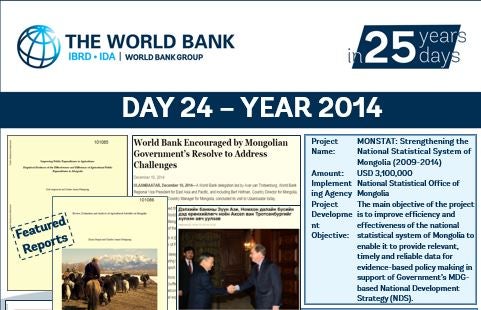 Continuing our series on the 25 years since Mongolia joined the World Bank, today we look at 2014. Growth was 7.8 percent, but inflation was in double-digits and FDI continued to fall. The World Bank’s economic updates continued to warn of persistent macroeconomic imbalances, and sector studies focused on financing.
Continuing our series on the 25 years since Mongolia joined the World Bank, today we look at 2014. Growth was 7.8 percent, but inflation was in double-digits and FDI continued to fall. The World Bank’s economic updates continued to warn of persistent macroeconomic imbalances, and sector studies focused on financing.
The rapid growth rates of the previous years, combined with the bent for decentralization, led to a natural desire to explore new possibilities for subnational finance. To this end, a pair of studies in 2014 aimed at preparing a debt management approach for Ulaanbaatar and a financial self-assessment for the city. The former stressed “the need to first build local institutional capacity for an effective and transparent debt management system before any borrowing is considered. … UB should use this time to put in place a debt management system so that it is prepared for borrowing once it is ready and the macroeconomic conditions improve.” The latter study examined what it would take for Ulaanbaatar to improve its credit quality and thereby prepare for an official rating from a credit rating agency. The recommendations centered on improving the city’s financial reporting system, strengthening its capital investment planning process, improving its capital asset registry, strengthening the oversight of municipal-owned enterprises and their debts, and identifying Ulaanbaatar’s contingent liabilities, both explicit and implicit.
Also in 2014, the World Bank, in partnership with the Ministry of Health, the World Health Organization, and the Joint Learning Network for Universal Health Coverage (UHC), produced the first-ever comprehensive and in-depth assessment of health payment systems in Mongolia. “The assessment showed that the general direction of health care provider payment policy has been effective. Many of the pitfalls observed in other middle-income countries have largely been avoided. The health system objective of achieving UHC is supported by the overall provider budget cap, which has helped control cost escalation in the health sector.” The assessment also reported that line item budget restrictions are a major impediment to improving health service delivery, and concluded that “although more flexibility needs to be introduced … a major overhaul of the payment systems does not seem to be necessary for Mongolia.” Following the assessment, a roadmap to improve health care provider payment systems, covering the next five years, was also agreed upon among key policymakers and providers through a consultative process.
Other analytical work also focused on how to make better use of Mongolia’s limited budget capacity. A review of agricultural subsidies found that subsidies had been essentially compensating for lower prices, rather than supporting productive capacity, and urged better monitoring of economic, environmental, and fiscal impacts of agricultural subsidies. A review of public expenditures in agriculture highlighted the limited capacity for planning, budgeting, and evaluating budgetary performance.
In mid-2014, four new IDA projects were approved, all building on long-standing areas of cooperation between Mongolia and the World Bank. The Education Quality Reform Project (EQRP) follows a long series of earlier education projects, such as those providing libraries for every rural classroom, building schools and improving training, and financing kindergartens in Ulaanbaatar and the countryside. The EQRP aims to create a results focus within the education system and strengthen the country’s capacity to provide classroom-level support for teaching and learning in every primary school in the country. The EQRP joined another project in the education portfolio, one addressing an enduring challenge: The Improving Primary Education Outcomes for the Most Vulnerable Children in Rural Mongolia project, which is supported by the Japan Social Development Fund (JSDF), helps prepare nomadic herders’ children for school. (Videos here and here.)
The SMART Government and E-Health projects similarly draw on a history of successful interventions to support Mongolia’s Information and Communication Technologies (ICT) development. (Videos here and here.) The SMART Government project will harness ICT to improve accessibility, transparency and efficiency of public services in Mongolia, supporting the Government’s vision of leveraging the ICT sector as a key driver of growth, competitiveness, and improved governance. The E-Health Project will take advantage of Mongolia’s vast broadband infrastructure to ensure faster access, even in remote areas, to more integrated health information systems across the country to process referrals faster, avoid duplication of tests and procedures, and provide follow-up care.
The Third Sustainable Livelihoods Project also builds on earlier progress, following its two predecessors with the aim of supporting rural livelihoods. (Video here). Supported by IDA and a grant from the Swiss Agency for Development and Cooperation (SDC), the project aims to improve local governance and decentralization by supporting capacity for local government and communities and providing performance-based financing for good governance.
And, in 2014, Country Manager Coralie Gevers left Mongolia after four years for a new position in Madagascar and Comoros. After many years working in Europe, central Asia, and Vietnam, I returned to Mongolia, the place where I began my development career in the early 1990s. After digging through my archives, I eventually found the proper tweet to mark my return.
Next we conclude our series of blogs on the 25 year partnership between Mongolia and the World Bank, looking at 2015, a year focused on knowledge and collaboration.
Prepared in collaboration with Pagma Genden.
(Please follow our 25 years in 25 days journey here and on twitter with the hashtag #WBG_Mongolia25th)


Join the Conversation